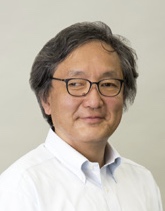
上田 太郎 教授
Taro Q.P. Uyeda
専門分野
分子生物物理学
細胞が動く仕組みを分子の働きから探る
研究テーマ
細胞が動く仕組み/生体分子モーターの力発生メカニズム/タンパク質フィラメントの協同的構造多型性
キーワード
アクチン,アクチン結合タンパク質,ミオシン,協同的構造多型性,アロステリー
LINKS
RESEARCH OVERVIEW
研究概要
細胞の動きは見ていて飽きることがありません。アメーバ運動にしろ、筋肉の収縮にしろ、精子の遊泳運動にしろ、細胞の運動は、いずれもタンパク質分子モーター系とよばれる一群のたんばく質の働きに依存しています。タンパク質分子モーター系は、ATPとよばれる化学物質の分解により駆動されるので、化学エネルギーを力学エネルギーに変換するナノサイズのエネルギー変換素子と見ることができます。そのエネルギー変換機構については長い研究の歴史があり、教科書にはわかったような説明が出ています。しかし現在主流となっているそうした仮説では説明のできない現象も多々あり、大きな秘密がまだ残されていることは間違いありません。では主流派の考え方の何が問題なのかというと、激しい熱運動に晒され決定論的な動作が不可能なナノ素子の動作原理を、決定論的なメカニズムで動くマクロな機械の延長で理解しようとしているところだと思われます。われわれは、ナノサイズの分子機械の動作原理には、マクロなサイズの機械とは異なる、熱ゆらぎに基づいた動作原理があるはずだという前提に立ち、分子生物学と生物物理学の合わせ技でこの謎に迫っていこうとしています。
一方、細胞が適切に運動するためには、細胞各部が協調的に伸びたり縮んだりする必要がありますが、タンパク質分子モーターの活性が細胞内の場所によって異なる制御受ける仕組みはよくわかっていません。われわれは、タンパク質分子モーター系の重要な構成要素であるアクチンフィラメントが、周囲の力学環境などを感知して構造を変化させるインテリジェントな分子機械であることを見出しています。そこで、アクチンフィラメントの力学感受性が、細胞運動の統御に重要な働きをしているという仮説をたて、その検証にも挑んでいます。
生物現象は一見きわめて多様ですが、その背後に共通する基本原理を分子レベルで解明しようという姿勢が生物物理学の重要な柱になると考えています。
MESSAGE to STUDENTS
学生へのメッセージ
大学院生は募集していません。
学歴・経歴
1980.3. 東京大学工学部電子工学科卒業
1982.3. 同 理学部植物学科卒業
1987.3 同 大学院理学系研究科植物学専門課程 博士課程修了 理学博士
1988.10 スタンフォード大学医学部細胞生物学教室 ポストドクトラルフェロー
1993.7 通商産業省 工業技術院 産業技術融合領域研究所 主任研究官
2001.4 独立行政法人 産業技術総合研究所 (機構改革により)主任研究員
2016.4 現職
所属学協会
- 日本生物物理学会
- 日本細胞性粘菌学会

Taro Q.P. Uyeda
Professor
Field of study
Molecular Biophysics
Deciphering the molecular basis of cell motility
Research Themes
Mechanism of cell motility/Force generation by molecular motors/Cooperative polymorphism of protein filaments
Keywords
Actin, Actin binding proteins, Myosin, Cooperative polymorphism, Allostery
RESEARCH OVERVIEW
“Movement” is intrinsic to life. It is fascinating to observe aspects of movements such as moving cells and molecular motors under a microscope. Our goal is to understand the mechanisms of cell motility through research at cellular and molecular level. We are particularly interested in cellular slime molds as a model organism with unique characteristics of eukaryotic cell movement, and in actin filaments, one of the major components of the cytoskeletal system.
Actin is a highly conserved protein and one of the most abundant in eukaryotic cells. It is becoming clear that actin has a highly polymorphic structure and it exhibits cooperative behavior. Currently, we are mainly focused on research involving structural polymorphism and functional differentiation of actin filaments.
MESSAGE to STUDENTS
Not accepting graduate students.
Education and Career
1980.3 B.Eng. Department of Electronic Engineering, Faculty of Engineering, The University of Tokyo
1982.3 B.S. Department of Botany, Faculty of Science, The University of Tokyo
1987.3 D.Sc. Graduate School of Science, The University of Tokyo
1988.10 Postdoctoral Fellow, Department of Cell Biology, Stanford University School of Medicine
1993.7 Senior Researcher, National Institute for Advanced Interdisciplinary Research, Agency for Industrial Science and Technology
2001.4 Senior Researcher, National Institute Advanced Industrial Science and Technology
2016.4 Curerent position
Professional Memberships
- The Biophysical Society of Japan
- Japanese Society for the Study of Cellular Slime Molds
